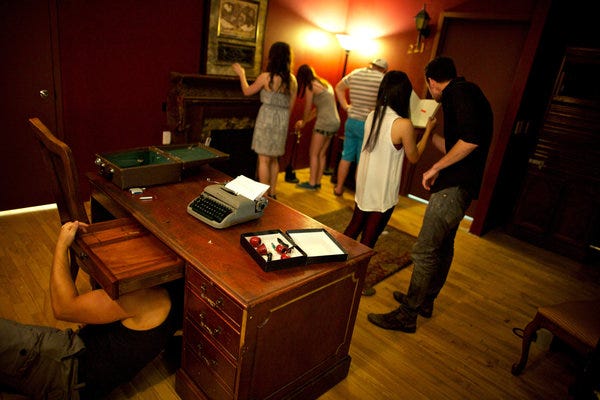Explore Why Escape Rooms Are Fun and Deal a Distinct Way to Bond With Pals and Household
Retreat areas have emerged as a fascinating type of amusement, offering a blend of immersive storytelling and psychological excitement that is both tough and rewarding. What precisely establishes getaway areas apart as a bonding experience?

Immersive Narration
While the idea of retreat rooms might originally seem simple, it is the immersive narration that genuinely establishes them apart. These experiences are carefully made to transfer individuals into one more globe, weaving engaging narratives that involve and captivate. From the moment gamers enter the room, they are covered in a carefully crafted atmosphere, total with detailed information, sound impacts, and thematic aspects that offer to boost the storyline.
Each escape space includes an one-of-a-kind story, frequently including an objective or secret that individuals have to solve within a set timeframe. The storyline is not merely a backdrop however is important to the experience, affecting the layout of problems and the format of the area. This narrative-driven strategy ensures that every element, from the clues to the decor, adds to the unfolding story, creating an immersive and cohesive environment.
In addition, the use of advanced technology and interactive attributes better grows the immersive experience. Electronic user interfaces, increased truth, and sensory effects can make the story come active, permitting participants to feel as though they are truly component of the unraveling dramatization. This immersion fosters a sense of exhilaration and seriousness, raising the overall satisfaction of getaway rooms.
Mental Stimulation
Participating in retreat spaces uses individuals an unique form of psychological excitement that tests cognitive abilities in revitalizing and varied ways. These immersive experiences call for people to solve detailed challenges, analyze codes, and think seriously under time constraints. This setting fosters boosted problem-solving abilities, as participants have to navigate a collection of complex obstacles that require sensible reasoning and creativity.
Retreat rooms commonly incorporate a range of problem types, from mathematical formulas to linguistic puzzles and spatial recognition tasks. This selection ensures that different cognitive features are engaged, supplying a comprehensive mental exercise. Solving a cipher may develop logical skills, while a physical puzzle may boost hand-eye coordination and spatial reasoning. The requirement to move in between different types of believing maintains the mind dexterous and involved.
In addition, the time-sensitive nature of escape rooms adds an element of pressure that enhances cognitive performance. Participants are encouraged to think quickly and efficiently, improving their ability to process information and choose rapidly. This heightened state of mental task can bring about raised emphasis and sharper cognitive capacities, making getaway spaces not only an amusing diversion but also a valuable workout for the mind.
Team Effort and Teamwork
Memorable Experiences
Frequently, among one of the most compelling elements of retreat areas is the production of remarkable experiences that linger long after the video game has ended. The immersive nature of getaway rooms, with their complex challenges and engaging storylines, provides individuals with a feeling of accomplishment and friendship that is tough to replicate in various other social activities. These experiences end up being valued memories, often recounted with enthusiasm and nostalgia.
The joint initiative needed to solve the obstacles promotes a special feeling of unity among participants. Friends and household members are given the possibility to work with each other in a high-pressure, yet enjoyable atmosphere, enhancing and reinforcing bonds communication skills (best escape room orlando). The shared victories and even the periodic failings add to a cumulative sense of success and happiness
Furthermore, the thematic diversity of retreat rooms makes certain that each experience stands out. Whether navigating a haunted manor or decoding hints in a spy-themed setting, the variety maintains the exhilaration fresh and the memories brilliant. This range not only caters to various rate of try this site interests but likewise makes sure that each browse through to a getaway area is an unique adventure.
In significance, getaway areas provide unforgettable experiences that build lasting links and offer tales to be cherished for many years to find.
Verdict
Getaway areas provide a distinct avenue for bonding with their immersive narration, psychological stimulation, and reliance on synergy and cooperation. Getaway areas arise as a unique and satisfying activity, integrating amusement with the development of vital social and cognitive abilities.

Structure on the foundation of team effort and cooperation, the excitement of the challenge in getaway areas provides individuals an exhilarating experience that checks their problem-solving capabilities and psychological acuity - escape room in orlando.Moreover, the very carefully crafted intricacy of escape spaces makes certain that no two experiences are alike.Commonly, one of home the most engaging aspects of getaway spaces is the production of unforgettable experiences that remain long after the video game has concluded.Additionally, the thematic variety of retreat rooms guarantees that each experience is unique